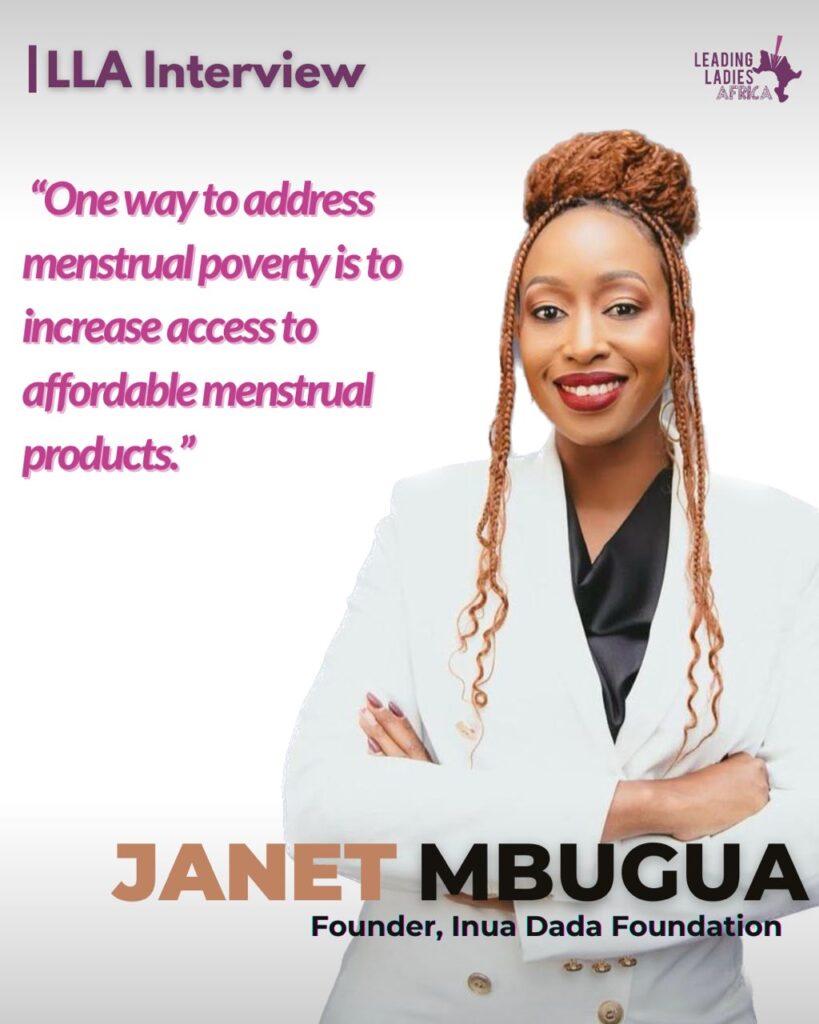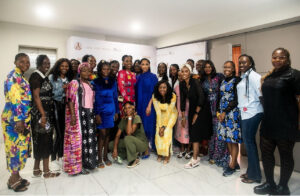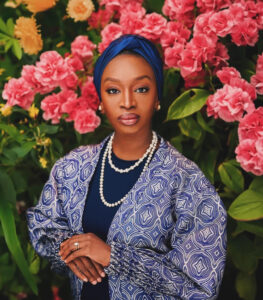
Can you share with us your personal journey and what inspired you to become a menstrual advocate?
My background in media and communications over the last 17 years, has allowed me to engage with communities, students, brands, government and policy makers, in taking a multi-sectoral and inclusive approach in advocating for gender equality rights and equity for all. My passion for social justice was fully born when I was a Broadcast Journalist.
A feature story that aired on the station I worked for at the time, showed girls using unsanitary products such as chicken feathers and goat hide to manage their menstruation. The feature became part of my then talk show. It birthed in me the need to push for girls and women to be able to access the right products and information pertaining to their period, while also pushing for the budgetary allocation to be increased in the Kenyan parliament.
Months later, in 2014, I formed my foundation and to date I have been intentional about sounding the alarm necessary in the fight to end period poverty, equip allies with the tools necessary in advocating in their communities, approaching menstrual health management with inclusive programs and promoting empathy and tolerance in communities where taboos and discrimination against women and girls continue to lock many girls out of an education and prevent women from working with dignity.
I appreciate the importance of using my digital space not only to inspire people or share some insights in to my life’s passions and activities, but also to bring key messaging and campaigns, particularly related to sexual and reproductive health and rights, cyber bullying and child safety, to life.
What are the biggest challenges and stigmas surrounding menstruation in African communities, and how do you address them?
The biggest challenges are stigma and poverty, which set many girls and women back from thriving or competing in school or at work. We address these through community dialogue sessions (names Tandika Leso) and advocacy through youth advocacy, our book My First Time and podcast of the same name and through continued mainstreaming of the conversation in collaboration with mainstream and digital media partners.
How do you engage with local communities and organizations to drive change and break the taboos associated with menstruation?
We work jointly with schools and if it’s outside of education settings, we work with social workers and community champions, many of whom are from the areas where we carry out our work.
In your opinion, what are the most pressing issues that need to be addressed in order to ensure better menstrual health and hygiene for women and girls in Africa?
Prioritization of Menstrual Health as a development agenda, ensuring that duty bearers make provisions for Menstrual products and information across institutions, a lot more education and awareness from school level, communities, media and more and a holistic and intentional approach to addressing Menstrual Health, including access to WASH facilities.
How do you work towards destigmatizing menstruation and creating a safe and supportive environment for women and girls to manage their periods?
Destigmatizing menstruation and creating a safe and supportive environment for women and girls to manage their periods involves a multi-faceted approach. Here are some steps that can be taken towards achieving this goal:
1. Education: Educating people about menstruation, the biology behind it, and the various menstrual hygiene products available can help break down the stigma surrounding periods. This can be done through school curriculums, workshops, and awareness campaigns.
2. Access to menstrual hygiene products: Ensuring that menstrual hygiene products are affordable and easily accessible can help women and girls manage their periods with dignity. This can be achieved through government subsidies, donations, and partnerships with non-governmental organizations.
3. Safe and private facilities: Providing safe and private facilities such as toilets, handwashing stations, and waste disposal systems can help women and girls manage their periods with dignity. This can be done through government initiatives or private sector partnerships.
4. Breaking cultural taboos: Addressing cultural taboos surrounding menstruation can help break down the stigma. This can be done by engaging with community leaders and influencers, and promoting positive messages about menstruation in the media.
5. Empowering women and girls: Empowering women and girls to talk openly about their periods and advocate for their rights can help create a more supportive environment. This can be achieved through mentorship programs, leadership training, and support groups.
By taking these steps, we can work towards destigmatizing menstruation and creating a safe and supportive environment for women and girls to manage their periods.
Can you share any success stories or impactful outcomes that have resulted from your advocacy work?
Advocacy efforts have played a key role in advancing rights and social justice causes. Advocacy efforts have also played a key role in improving public health. For instance, advocacy campaigns have helped to increase awareness and funding for relevant research and interventions. Advocacy work has led to important policy changes and protections.nOverall, advocacy work has played a critical role in advancing important causes and achieving positive outcomes across a wide range of issues. At Inua Dada Foundation, this has been achieved in the following interventions:
Inua dada Foundation has had significant success in MHM intervention especially through advocacy through storytelling, convening communities for awareness and education and production and provision of health products. This has been attained through various programs some of which are highlighted as under:
Inua dada minute – short 59 second snapshot of issues & call to action on MHM issues
Inua dada voices – Youth activations & hangouts for half to full day featuring sessions where they make their voices be heard
Tandika Leso sessions – Community dialogues featuring thematic subject matter
My First Time sessions – Featured 29minute story telling on live experience on diverse themed issues regarding MHM and advocacy
Custom co-created awareness sessions – that are tailor made ctivities such as sports for awareness, hike for awareness, cook out sessions while sharing experiences, etc
Gender Equality Forums – with featured interventions on GBV, empowerment to bridge gender inequalities through e.g. financial literacy, pad production and activations at forums with multi-stakeholders in gender equality
School engagements through all existing tiers within learning institutions involving governance, instructors, non teaching staff and students from primary, secondary and tertiary learning institutions.
Speaking engagements in local, regional and global platforms. Activities include training youth in high school with tools on advocacy, training primary school children on Menstrual health and more.
How do you address the issue of menstrual poverty and ensure that marginalized communities have access to affordable menstrual products?
Menstrual poverty is a significant issue that affects especially marginalized and resource strapped communities and it is important to address this issue in order to promote gender equality and ensure that people who menstruate are able to live healthy and dignified lives.
One way to address menstrual poverty is to increase access to affordable menstrual products. This can be done through a variety of means, such as government subsidies, partnerships with non-governmental organizations (NGOs), and the development of low-cost menstrual product options.
IDF plays an important role in production as well as distributing affordable menstrual products to marginalized communities. Some organizations have developed reusable menstrual products, such as menstrual cups and cloth pads, which are more affordable and sustainable than disposable products. This is attained by working with local communities and government agencies to distribute these products and provide education on menstrual health and hygiene.
Governments can also play a role in addressing menstrual poverty by providing subsidies for menstrual products or by distributing them through public health clinics, schools, and other community centers. In addition, governments can work to eliminate the taxes on menstrual products, which can make them more affordable for low-income individuals and families.
Finally, addressing the root causes of poverty and inequality is crucial for ensuring that marginalized communities have access to menstrual products and can live healthy and dignified lives. This includes addressing issues such as lack of access to education, healthcare, and employment opportunities, which disproportionately affect women and marginalized groups.
How do you engage with young girls and adolescents to provide them with accurate information about menstruation and promote positive attitudes toward it?
Engaging with young girls and adolescents is critical for providing them with accurate information about menstruation and promoting positive attitudes toward menstrual health. Here are some ways that this can be done:
1. Education in schools: Schools play an important role in educating young girls and adolescents about menstruation. This can be done through health education classes or workshops, which can provide accurate information about menstrual health and hygiene and address common myths and misconceptions. Schools are a good entry point that can also provide access to menstrual products and ensure that restroom facilities are clean and well-stocked with necessary supplies.
2. Community dialogues and workshops: Community workshops can also be a valuable tool for engaging with young girls and adolescents especially out of schooland providing them with accurate information about menstruation. These workshops can be led by healthcare providers, community leaders, or NGOs, and can cover a range of topics related to menstrual health, including menstrual hygiene, menstrual product options, and menstrual cycle tracking.
3. Peer-to-peer education: Peer-to-peer education can be an effective way to promote positive attitudes toward menstruation and to break down stigma and shame surrounding the topic. This can be done through peer-led workshops, mentoring programs, or social media campaigns that encourage young girls and adolescents to share their experiences and support one another.
4. Multimedia resources: Multimedia resources such as videos, podcasts, and social media graphics can also be effective in engaging young girls and adolescents and providing them with accurate information about menstruation. These resources can be easily shared and accessed through social media platforms, which are popular among young people.
Overall, engaging with young girls and adolescents through a variety of channels can help to promote positive attitudes toward menstruation and ensure that they have access to accurate information about menstrual health.
What are your future goals and aspirations as a menstrual advocate, and how do you plan to expand your impact?
We are working to expand impact in menstrual health management by ensuring that the key enablers to the same are addressed. the enablers entail:
Education and Awareness – where by girls receive inadequate education on menarche, puberty, and MHM, and lack the necessary information channels for ongoing support, mentorship, and knowledge.
Products – considering that high costs and distribution challenges limit the accessibility of menstrual products such as disposable pads to the majority of low-income girls and women, especially in rural areas and resource limited settings such as informal settings in the urban and prei-urban areas. Even with anincrease in low-cost sanitary pad enterprises, their reach is still limited.
Sanitation – Awareness of WASH (water, sanitation and hygiene) needs for proper MHM exists, butMHM is still under-prioritized given significant gaps in access to sanitation facilities in
urban, low-income settings.
Policy – There is growing national attention to MHM with the National Sanitary Towels Program for school girls and development of national MHM guidelines however, monitoring and enforcement is still limited.
One key goal of menstrual advocates is to increase access to menstrual products and education for marginalized communities. This can be done through a variety of means, such as lobbying forgovernment subsidies, partnerships with NGOs and other organizations, and the development of low-cost menstrual product options.
As a menstrual advocates also working to break down stigma and shame surrounding menstruation, particularly in cultures where menstruation is still considered taboo. This can be done through education campaigns, community workshops, and social media campaigns that encourage open dialogue and promote positive attitudes toward menstrual health.
In addition, working to address the environmental impact of disposable menstrual products and promote sustainable menstrual product options. This includes promoting the use of reusable menstrual products and advocating for policies and regulations that promote sustainability and reduce waste.
To expand their impact, working to collaborate with a wide range of stakeholders, including governments, NGOs, healthcare providers, educators, and community leaders. By working together, can leverage collective resources and expertise to promote menstrual health and hygiene, increase access to menstrual products, and break down stigma and shame surrounding menstruation.
Overall, the goal as a menstrual advocates is to promote menstrual health and hygiene as a basic human right, and to ensure that everyone who menstruates has access to the products and support they need to live healthy, dignified lives.
Finally, what advice would you give to individuals who want to get involved in menstrual advocacy and make a difference in their communities?
If one is interested in getting involved in menstrual advocacy and making a difference in your community, here are some tips to get started:
1. Educate yourself: Learn about the issues surrounding menstrual health and hygiene, including the challenges faced by individuals who menstruate. You can read books, articles, and reports, and watch documentaries to deepen your understanding.
2. Join a local organization: Find a local organization that focuses on menstrual health and hygiene. This could be a non-profit organization, a community group, or a student group. Joining an organization can help you connect with like-minded individuals and gain valuable experience.
3. Volunteer: Many organizations need volunteers to help with events, outreach, and advocacy efforts. Look for opportunities to volunteer your time and skills to support menstrual health and hygiene initiatives in your community.
4. Advocate: Use your voice to raise awareness about menstrual health and hygiene, and advocate for policy changes that support menstrual equity. This can include writing letters to elected officials, sharing information on social media, and speaking up at community meetings.
5. Donate: Consider making a financial donation to a local organization that focuses on menstrual health and hygiene. Even a small donation can make a big difference.
Remember that menstrual advocacy is an ongoing effort, and it takes time and commitment to make a meaningful impact. But by taking these steps, you can help support menstrual equity in your community and beyond.



